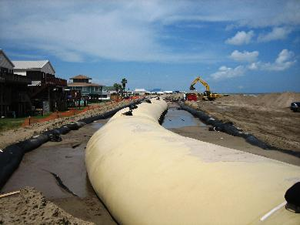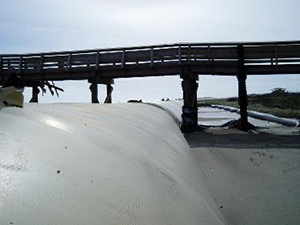 In June 2009, Tencate Geosynthetics North America reported that it was working with the US Army Corps of Engineers on rehabilitating and protecting the coastline of Grand Isle (Louisiana, USA). A row of TenCate Geotube® GT500 containers measuring 9,600 metres in length forms the core of what will ultimately be a row of dunes. The containers replace a series of burritos that the Corps had originally chosen but which had succumbed to the elements. The TenCate Geotube® units, however, are doing just fine — as a report broadcast by WWLTV (Eyewitness News) clearly showed.
In June 2009, Tencate Geosynthetics North America reported that it was working with the US Army Corps of Engineers on rehabilitating and protecting the coastline of Grand Isle (Louisiana, USA). A row of TenCate Geotube® GT500 containers measuring 9,600 metres in length forms the core of what will ultimately be a row of dunes. The containers replace a series of burritos that the Corps had originally chosen but which had succumbed to the elements. The TenCate Geotube® units, however, are doing just fine — as a report broadcast by WWLTV (Eyewitness News) clearly showed.
The dunes (burritos) that the Corps had built here after Katrina consisted of geotextiles filled with sand and then sewn together — a construction that proved unequal to the hurricanes Gustav and Ike. The core of the new row of dunes consists of a chain of TenCate Geotube® units with erosion mats in front and behind.
 Each tube (65 metres long and 10 meters in circumference) is filled with a mixture of sand and water that, after hardening, is expected to last 100 years. After being installed, the tubes are covered with a million cubic metres of sand from the seabed.
Each tube (65 metres long and 10 meters in circumference) is filled with a mixture of sand and water that, after hardening, is expected to last 100 years. After being installed, the tubes are covered with a million cubic metres of sand from the seabed.
Earlier this year the Army Corps of Engineers began installing new TenCate Geotube containers to replace the so-called burrito levee. This levee stretched 2.4 kilometres across the island and was part of the emergency repair work in the wake of Gustav.
It was ‘a tricky bit of work’ to thread the row of containerst through the piers, but the IAI crew did it.












